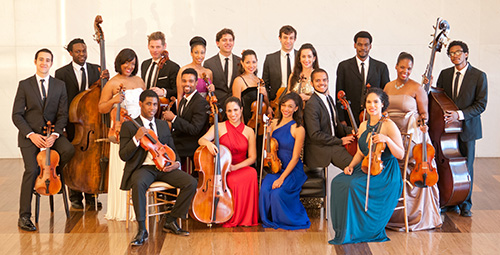JPMorgan Chase & Co. and the Sander and Norma K. Buchman Fund present The Sphinx Virtuosi in Review
JPMorgan Chase & Co. and the Sander and Norma K. Buchman Fund present
The Sphinx Virtuosi
Isaac Stern Auditorium/Ronald O. Perelman Stage at Carnegie Hall
October 20, 2016
The Sphinx Virtuosi delivered another of their brilliant, fierce, dedicated, and inspiring programs on Thursday night, celebrating the eve of their twentieth year of standing as a sort of rebuke to the hidebound institutions of classical music—insisting on representation, participation, education, and development of Black and Latino musicians. For those who don’t know, the Virtuosi are composed of eighteen string players, all laureates of the Sphinx Competition, yet another part of the organization’s total outreach. The Virtuosi play as a conductorless chamber string orchestra. The sum total of all Sphinx Organization activities is much more important than any one concert given: may their efforts not only thrive but increase.
The program had a very single-minded focus on this occasion: Viajes Latinos (Latin Voyages). It sought also to redress an imbalance of programming that usually favors only standards, by presenting music of various South American composers (and one Spanish, one Mexican), though some of those are pretty much household names by now. In fact, my only wish would be that they had strayed farther afield into even more obscure music, even by the well-known names.
To attend a program of all-Latin music, one had best have made one’s peace with ostinati, since the lion’s share of the works possess this motoric drive. I could have wished for more meditative works, but I realize that generating excitement has a mission too.
The program began with Astor Piazzolla’s well-loved Libertango, played with rhythmic snap and great sound, although this arrangement robbed the tango of some of the bite that is usually present when bandoneon or piano are employed. Attraction and repulsion are the essence of the tango.
They followed this with the Mexican composer Javier Alvarez’ Metro Chabacana, named for and commissioned by (!) a subway station in Mexico City. (How about it MTA: Bryant Park Blues?) This was beautifully played, and one could hear the pulse of urban life both above and below ground.
The Last Round, for the unusual instrumentation of two “competing” string quartets and one “moderating” double bass, by Osvaldo Golijov followed. It was inspired partly by the death of Piazzolla, and the antagonism of the tango found its metaphor in the two quartets, who traded sultry moves between them, while the bass contributed rhythmic punctuation. Its concluding section, the mournful part, was absolutely haunting.
A phenomenal young violinist and recent prize winner, Hannah White, then took the stage to blaze her way through the only true novelty of the evening: César Espejo’s Prélude Ibérique, for unaccompanied violin. Espejo, from Spain, lived most of his life in France. His work carries figurations from Bach, with important mixtures of flamenco and even tzigane (gypsy) thrown in. White commanded every bit of the work, with perfect intonation, technique, flair, swing: in short, everything one could ask for from a violinist, of any age.
Heitor Villa-Lobos is also a name that really needs no introduction. In this section of the program, the “heart” of the Sphinx group, a quartet named Catalyst, performed the famous Aria from his Bachianas Brasileras No. 5. Despite perfect playing, I felt the piece was robbed of a bit of its humanity with the lack of the human voice soaring over its long lines. This led me to wonder about the inclusion of winds and voices to the Sphinx agenda. Is it possible, or have they already beat me to it?
The Catalyst group then segued directly into another Piazzolla “hit”: La Muerte del Angel, originally part of a movie score. Here the quartet was in stunning form, with elegiac sound, and great flexibility due to listening intently to each other (a property possessed by the entire Sphinx group: if I were to make a bad pun, I’d call them “Black Orpheus,” but that would short-change the Latinos.).
After a concise but moving video of the program’s influence and mission, some remarks were made, and an award was presented to a major patron, Robert F. Smith, the first African-American chairman of the board of Carnegie Hall.
The concert then concluded with a fiery account of Alberto Ginastera’s Finale furioso from his Concerto per corde, Op. 33 (an arrangement of a previous string quartet). The energy was almost unbearable, in a good way! The audience, refreshingly composed of many younger faces of color, leapt to its collective feet.

